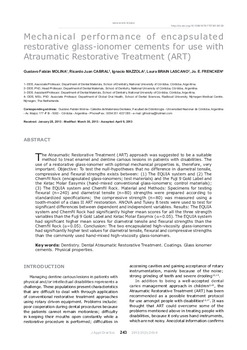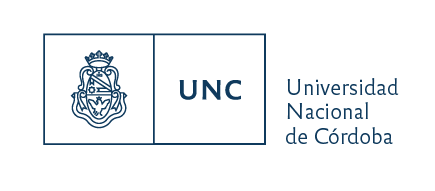| dc.contributor.author | Molina, Gustavo Fabián | |
| dc.contributor.author | Cabral, Ricardo Juan | |
| dc.contributor.author | Mazzola, Ignacio | |
| dc.contributor.author | Brain Lascano, Laura | |
| dc.contributor.author | Frencken, Jo. E. | |
| dc.date.accessioned | 2019-10-29T16:05:53Z | |
| dc.date.available | 2019-10-29T16:05:53Z | |
| dc.date.issued | 2013 | |
| dc.identifier.issn | 1678-7757 | |
| dc.identifier.uri | http://hdl.handle.net/11086/13491 | |
| dc.description.abstract | The Atraumatic Restorative Treatment (ART) approach was suggested to be a suitable method to treat enamel and dentine carious lesions in patients with disabilities. The use of a restorative glass-ionomer with optimal mechanical properties is, therefore, very important. Objective: To test the null-hypotheses that no difference in diametral tensile, compressive and flexural strengths exists between: (1) The EQUIA system and (2) The Chemfil Rock (encapsulated glass-ionomers; test materials) and the Fuji 9 Gold Label and the Ketac Molar Easymix (hand-mixed conventional glass-ionomers; control materials); (3) The EQUIA system and Chemfil Rock. Material and Methods: Specimens for testing flexural (n=240) and diametral tensile (n=80) strengths were prepared according to standardized specifications; the compressive strength (n=80) was measured using a tooth-model of a class II ART restoration. ANOVA and Tukey B tests were used to test for significant differences between dependent and independent variables. Results: The EQUIA system and Chemfil Rock had significantly higher mean scores for all the three strength variables than the Fuji 9 Gold Label and Ketac Molar Easymix (α=0.05). The EQUIA system had significant higher mean scores for diametral tensile and flexural strengths than the Chemfil Rock (α=0.05).
Conclusion: The two encapsulated high-viscosity glass-ionomers had significantly higher test values for diametral tensile, flexural and compressive strengths than the commonly used hand-mixed high-viscosity glass-ionomers. | en |
| dc.description.uri | http://dx.doi.org/10.1590/1679-775720130129 | |
| dc.format.medium | Electrónico y/o Digital | |
| dc.language.iso | eng | en |
| dc.rights | Attribution-NonCommercial-ShareAlike 4.0 International | * |
| dc.rights.uri | http://creativecommons.org/licenses/by-nc-sa/4.0/ | * |
| dc.subject | Glass ionomers | en |
| dc.subject | Cements | en |
| dc.subject | ART | en |
| dc.subject | Mechanical properties | en |
| dc.title | Mechanical performance of encapsulated restorative glass-ionomer cements for use with Atraumatic Restorative Treatment (ART) | en |
| dc.type | article | en |
| dc.description.version | publishedVersion | |
| dc.description.fil | Fil: Molina, Gustavo Fabián. Universidad Nacional de Córdoba. Facultad de Odontología. Departamento de Materiales Dentales; Argentina. | es |
| dc.description.fil | Fil: Cabral, Ricardo Juan. Universidad Nacional de Córdoba. Facultad de Odontología. Departamento de Materiales Dentales; Argentina. | es |
| dc.description.fil | Fil: Mazzola, Ignacio. Universidad Nacional de Córdoba. Facultad de Odontología. Departamento de Materiales Dentales; Argentina. | es |
| dc.description.fil | Fil: Brain Lascano, Laura. Universidad Nacional de Córdoba. Facultad de Odontología. Departamento de Materiales Dentales; Argentina. | es |
| dc.description.fil | Fil: Frencken, Jo E. Universidad de Radboud. Facultad de Ciencias Odontológicas. Centro Médico de Nijmegen. Departamento de Salud Oral Global; Países Bajos. | es |
| dc.journal.city | San Pablo | |
| dc.journal.country | Brasil | |
| dc.journal.editorial | Universidad de San Pablo | |
| dc.journal.number | 3 | |
| dc.journal.pagination | 243-249 | |
| dc.journal.referato | Con referato | |
| dc.journal.title | Journal of Applied Oral Science | en |
| dc.journal.volume | 21 | |
| dc.description.field | Otras Ciencias de la Salud | |
| dc.identifier.eissn | 1678-7765 | |





